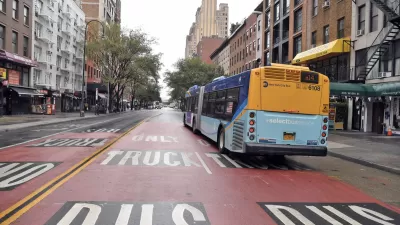Sharing lanes with car traffic may make it impossible for the MTA to increase service frequency.

Bus frequency in New York City is hindered by congestion, writes Dave Colon in Streetsblog NYC, making it practically impossible for the Metropolitan Transportation Authority (MTA) to meet a goal of improving frequency by 20 percent.
Buses will never beat a subway in terms of the total number of people one bus can move compared to a full subway train. But that doesn't mean buses need to provide significantly less bang for their buck, which is what happens when they're caught in a sea of double parked cars and trucks parked in the bus lane.
One potential solution is ramping up the use of automated enforcement to cite drivers who block bus lanes. “ABLE [Automated Bus Lane Enforcement] cameras have improved bus speeds by 5 percent on routes where they're used, and faster buses are of course one way to get more bus service for less money, as the Citizens Budget Commission pointed out in a policy brief on MTA finances in the dark days of 2021.” Yet New York’s buses are moving at the same speed now as in 2018—7.5 miles per hour.
Redesigning inefficient bus routes could also help speed up service. “City bus stops are notoriously close together compared to international peers, which means buses are constantly stopping and starting. The buses also run on long and circuitous routes that haven't been updated in decades, forcing drivers to navigate tight streets and wait out traffic to make left turns.”
Meanwhile, “A spokesperson for the MTA did not dispute the tenor of the budget negotiations, but focused on the fact that the transit system survived at all.”
FULL STORY: City Traffic Helps Make Bus Service Unbearable, Expensive And Difficult To Improve

Alabama: Trump Terminates Settlements for Black Communities Harmed By Raw Sewage
Trump deemed the landmark civil rights agreement “illegal DEI and environmental justice policy.”

Planetizen Federal Action Tracker
A weekly monitor of how Trump’s orders and actions are impacting planners and planning in America.

The 120 Year Old Tiny Home Villages That Sheltered San Francisco’s Earthquake Refugees
More than a century ago, San Francisco mobilized to house thousands of residents displaced by the 1906 earthquake. Could their strategy offer a model for the present?

Opinion: California’s SB 79 Would Improve Housing Affordability and Transit Access
A proposed bill would legalize transit-oriented development statewide.

Record Temperatures Prompt Push for Environmental Justice Bills
Nevada legislators are proposing laws that would mandate heat mitigation measures to protect residents from the impacts of extreme heat.

Downtown Pittsburgh Set to Gain 1,300 New Housing Units
Pittsburgh’s office buildings, many of which date back to the early 20th century, are prime candidates for conversion to housing.
Urban Design for Planners 1: Software Tools
This six-course series explores essential urban design concepts using open source software and equips planners with the tools they need to participate fully in the urban design process.
Planning for Universal Design
Learn the tools for implementing Universal Design in planning regulations.
Clanton & Associates, Inc.
Jessamine County Fiscal Court
Institute for Housing and Urban Development Studies (IHS)
City of Grandview
Harvard GSD Executive Education
Toledo-Lucas County Plan Commissions
Salt Lake City
NYU Wagner Graduate School of Public Service





























